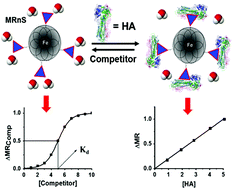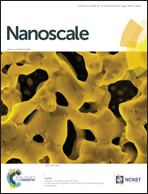Novel magnetic relaxation nanosensors: an unparalleled “spin” on influenza diagnosis†
Abstract
Rapid detection and diagnosis of pathogenic strains of influenza is necessary for expedited treatment and quicker resolutions to the ever-rising flu pandemics. Considering this, we propose the development of novel magnetic relaxation nanosensors (MRnS) for the rapid detection of influenza through targeted binding with hemagglutinin. 2,6- and 2,3-sialic acid ligands and entry blocker peptides are conjugated to iron oxide nanoparticles to create functional MRnS. Positive detection of various hemagglutinin variants (H1 and H5) is possible with protein concentrations as little as 1.0 nM. Most importantly, detection using functional MRnS is achieved within minutes and differentiates between influenza subtypes. This specificity allows mixtures of MRnS to screen for multiple pathogens at once, discarding the need to conduct multiple individual tests. Current methods used to diagnose influenza, such as RT-PCR and viral culturing, while largely effective, are complex, time-consuming and costly. As well, they are not as sensitive or specific, and have been known to produce false-positive results. In contrast to these methods, targeted MRnS are robust, point-of-care diagnostic tools featuring simple, rapid and low-cost procedures. These qualities, as well as high sensitivity and specificity, and low turnaround times, make a strong case for the diagnostic application of MRnS in clinical settings.

- This article is part of the themed collection: Coronavirus articles - free to access collection

 Please wait while we load your content...
Please wait while we load your content...